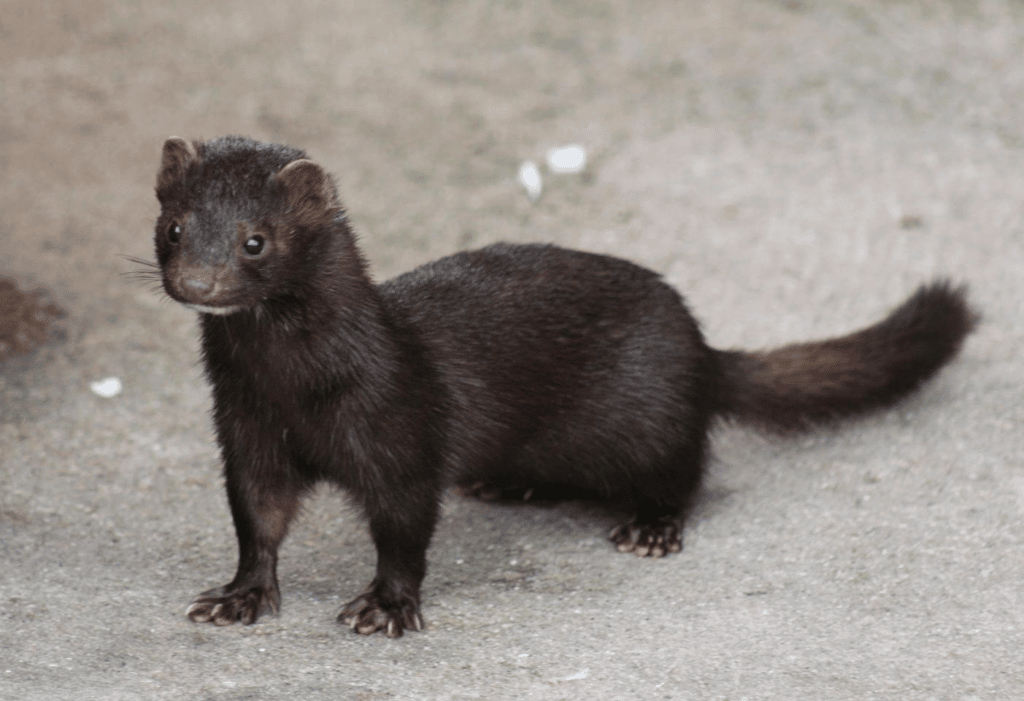Mink on a Spanish farm caught bird flu. Is the virus adapting to mammals?
By Matt Field | January 26, 2023
 Mink are susceptible to human respiratory diseases. Credit: Patrick Reijnders via Wikimedia Commons. CC BY-SA 3.0.
Mink are susceptible to human respiratory diseases. Credit: Patrick Reijnders via Wikimedia Commons. CC BY-SA 3.0.
Bloody snouts, clumsiness—these were among the signs last October that mink on a Spanish fur farm had a problem. The subsequent identification of the culprit, highly pathogenic avian influenza H5N1, now has health experts warning that humans might also be facing their own problem. So far the “bird flu” has affected about 60 million birds in the United States since the beginning of 2022 and tens of millions more around the world. But if the lethal pathogen were able to adapt to spread easily in mammals like mink, experts fear it could eventually do so in humans.
Mink are known to be susceptible to human respiratory diseases. And during the COVID pandemic, crowded farms dealt with repeated animal outbreaks, including some that infected workers. This led to fears that intensive mink farming could spawn dangerous new variants. Likewise, outbreaks of highly pathogenic avian influenza on farms could change the characteristics of a virus that at this point doesn’t transmit effectively among people. In the worst-case scenario, a mutated virus could spark a pandemic; a novel influenza could rip around the world in populations with little immunity. Virologist Elisa Pérez told the Spanish newspaper El Pais, “In Europe there had never been such an outbreak in mink before, there were only a few cases described in China. We had never had such a big scare.” Pérez told the newspaper that mink farms should be closed: “What else needs to happen?”
According to an article this month in the journal Eurosurveillance, the mink outbreak of highly pathogenic avian influenza H5N1 in A Coruna, a province in northwest Spain, began near a manure storage area. About 50,000 animals lived on the farm in wire cages in 30 partially open barns. Within weeks, the disease had spread across the complex and minks were dying at a rate of over 4 percent, up from an expected rate of 0.2 to 0.3 percent. The spread across the farm indicated “that an onward transmission of the virus to other minks may have taken place,” the authors wrote. “It can be assumed that wild birds may have played a major role in the virus introduction into the farm.”
Mink farms, where thousands of animals can share close quarters, could set up a corollary to a controversial experiment conducted more than a decade ago. That’s when a team in the Netherlands mutated highly pathogenic avian influenza H5N1 and infected ferrets with it. Researchers then took samples from those ferrets and used them to infect other ferrets. After several steps like this, the avian virus had evolved to spread through the air between mammals. Scientists on twitter noted that outbreaks on mink farms could similarly allow the avian virus to mutate as it spreads. “Such outbreaks of avian flu in mink farms are highly suboptimal,” Francois Balloux, a professor at the University College London’s Genetics Institute wrote, “as they create natural ‘passaging experiments’ in a mammalian host, which could lead the virus to evolve higher transmissibility in mammals.”
The World Health Organization’s incoming chief scientist, Jeremy Farrar, tweeted out his concern, as well. “Avian H5N1 has caused outbreaks in humans with high mortality now found transmit between minks. Risk of evolution in mammals & acquisition of [human to human] transmission,” he wrote.
Isabella Monne, a veterinarian at IZSVe, an institute with the Italian National Public Health Service, and one of the authors of the report, told the Bulletin that it’s not likely each affected animal came into contact with wild birds. “We may assume that the transmission was caused either by direct contact among infected animals or by indirect contact with infected biological materials.” She cautioned that while the infection likely spread on the farm, it’s not yet clear how. “Specific experimental trials are needed to clarify the transmissibility of the virus and in particular to define the capability of the virus to spread via the aerosol route.”
Minks are raised for their pelts, which are used in fashion. Before the COVID pandemic, El Pais reported, there were some 2,900 mink farms in the European Union. By the start of 2021, that number dropped to 755, as governments ordered culls and closures. But the industry could grow again. Denmark announced plans to import mink from other countries, including Spain, and to allow farming of the animals to resume this year.
No workers were infected at the Spanish farm. Nor did the mink farm viruses have the “most relevant … genetic changes” known to make the avian virus better adapted to humans, Monne said. Still, in the midst of what Monne called an “unprecedented panzootic”—a pandemic among animals—of highly pathogenic avian influenza, the farm outbreak qualifies as a red flag.
“The continuous circulation of the virus poses great risks and may result in more spillover events in mammals. This would undoubtedly cause consequences difficult to predict,” Monne said. “A virus that is able to transmit to mammals needs to be stopped before it may become a matter of public health concern as we learnt from the SARS-CoV2 lesson.”
Together, we make the world safer.
The Bulletin elevates expert voices above the noise. But as an independent nonprofit organization, our operations depend on the support of readers like you. Help us continue to deliver quality journalism that holds leaders accountable. Your support of our work at any level is important. In return, we promise our coverage will be understandable, influential, vigilant, solution-oriented, and fair-minded. Together we can make a difference.
Keywords: H5N1, bird flu, mink
Topics: Biosecurity














